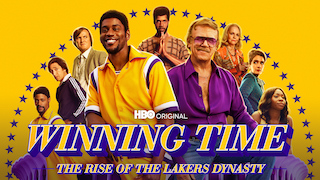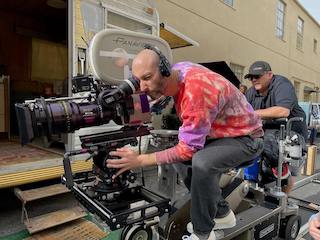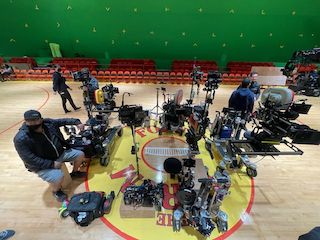 Winning Time: The Rise of the Lakers Dynasty is back for its second season on HBO, pushing deeper into the 1980s as it continues to recount the on- and off-court stories surrounding the Showtime era of the Los Angeles Lakers. After sharing cinematography duties with Mihai Malaimare Jr. on Season 1, Todd Banhazl, ASC returned for Season 2, now joined by fellow cinematographers John Matysiak, Ricardo Diaz and Darran Tiernan, ISC. As with the previous season, Season 2’s cinematographers embraced a mix of formats anchored around 35mm film acquisition with Panaflex Millenium XL2 cameras and Primo optics supplied by Panavision Woodland Hills. Banhazl spoke with Digital Cinema Report about their approach to evolving the show’s signature style, the keys to their seamless give-and-go from one episode to the next, and his experience taking over the director’s chair for Episode 3, The Second Coming.
Winning Time: The Rise of the Lakers Dynasty is back for its second season on HBO, pushing deeper into the 1980s as it continues to recount the on- and off-court stories surrounding the Showtime era of the Los Angeles Lakers. After sharing cinematography duties with Mihai Malaimare Jr. on Season 1, Todd Banhazl, ASC returned for Season 2, now joined by fellow cinematographers John Matysiak, Ricardo Diaz and Darran Tiernan, ISC. As with the previous season, Season 2’s cinematographers embraced a mix of formats anchored around 35mm film acquisition with Panaflex Millenium XL2 cameras and Primo optics supplied by Panavision Woodland Hills. Banhazl spoke with Digital Cinema Report about their approach to evolving the show’s signature style, the keys to their seamless give-and-go from one episode to the next, and his experience taking over the director’s chair for Episode 3, The Second Coming.
Digital Cinema Report: How has the look that was established with Season 1 evolved for this new season? What was added to the gameplan to further immerse viewers in the world of the Showtime Lakers?
Todd Banhazl, ASC: The idea this year was to let the formats shift and grow into the mid-’80s. This meant leaving behind some of the more romantic ’70s looks that we had come to love and embracing a more ‘plastic’ ’80s style. As the characters leave behind those golden early years, so do we.
 We also fell in love with 8mm and 16mm’s ability to capture intimate performance in a lean documentary way last year, so this year we wanted to further maximize how we could get these smaller-format cameras more ingrained into the overall style of the show. And, of course, we wanted to challenge ourselves to push the basketball photography way further in Season 2.
We also fell in love with 8mm and 16mm’s ability to capture intimate performance in a lean documentary way last year, so this year we wanted to further maximize how we could get these smaller-format cameras more ingrained into the overall style of the show. And, of course, we wanted to challenge ourselves to push the basketball photography way further in Season 2.
DCR: With a full season under your belt, did the show itself become the main visual reference, or did you continue to find inspiration in period advertising and elsewhere? Were there any particularly influential references you and your collaborators shared?
TB: A lot of our conversations surrounded the difference in how archival documentary footage looked in the ’60s and ’70s versus the mid-’80s. We also added new TV camera positions for the basketball games, modeled after TV broadcasts of the time — angles that are pretty tame by today’s standards but must have been really exciting for viewers at the time. For scenes in later episodes this season, we were referencing classic spaghetti westerns as well as John Ford westerns and the original Donner Superman. This is where the idea of shooting 16mm with Panavision anamorphic glass came from, so we could play with the epic myth of these characters’ backstories but also keep it grounded in the gritty Winning Time documentary style.
DCR: The core camera package was once again Primo optics and Millennium XL cameras. What brought you back to that combination?
 TB: The backbone of the Winning Time visual style is always our 35mm reversal print look using the XL cameras and Primos. We pushed the format more this year in terms of how dynamically we moved the camera, especially in basketball. And I found myself really pushing the highlights this year, but it was important to maintain one classic foundational look for the show to allow the other mixed formats to shift and grow as freely as possible, without confusing the audience.
TB: The backbone of the Winning Time visual style is always our 35mm reversal print look using the XL cameras and Primos. We pushed the format more this year in terms of how dynamically we moved the camera, especially in basketball. And I found myself really pushing the highlights this year, but it was important to maintain one classic foundational look for the show to allow the other mixed formats to shift and grow as freely as possible, without confusing the audience.
I also fell more in love with the wide end of the Primos for Season 2. The 10mm rectilinear and 14.5mm were particular favorites, along with an 8mm ‘distortion lens.’ They cut really nicely with the 16mm format on the long end of the zooms as well as the shaky handheld VHS footage. It was about striking a balance between epic and lo-fi.
DCR: What other acquisition formats were used throughout Season 2? Was anything new introduced this season?
TB: We started to gently phase out 8mm film and phase in consumer VHS-C cameras to help feel the transition from the ’60s and ’70s into the ’80s. We also further embraced shooting a modified version of 16mm that felt like a hybrid of 8mm and 16mm and allowed us to shoot full sound-sync takes more easily than 8mm. That format became the most exciting new tool for me. It was always there in the corner catching some hidden, beautiful performance beat from one of our brilliant actors.
DCR: For Season 2, you were joined by cinematographers John Matysiak, Ricardo Diaz and Darran Tiernan. How did the four of you collaborate to maintain the show’s unique style across your individual episodes?
 TB: I’m so indebted to my three fellow cinematographers this season. The episodes look seamless. Mostly it came down to the fact that these guys are brilliant and generous and did fantastic work. The key for me is always total communication and sharing ideas across DPs and episodes. The visual continuity across such an experimental style is also a testament to our gifted camera operators, including Dominic Bartolone, Jess Lakoff Cannon and Justin Cameron.
TB: I’m so indebted to my three fellow cinematographers this season. The episodes look seamless. Mostly it came down to the fact that these guys are brilliant and generous and did fantastic work. The key for me is always total communication and sharing ideas across DPs and episodes. The visual continuity across such an experimental style is also a testament to our gifted camera operators, including Dominic Bartolone, Jess Lakoff Cannon and Justin Cameron.
DCR: You reteamed with director Salli Richardson-Whitfield, with whom you’d worked on the final two episodes of Season 1. How did that creative collaboration evolve over the course of these new episodes?
TB: There is an alchemy between Salli and myself that I feel very grateful for. We bring the best out of each other, and have a similar drive to constantly push for something better. Something I love about Salli is that she’ll see a camera tool, lens, format or technique, and she’ll immediately lean into it. She’ll get excited about it, and then instantly start designing new ideas around that technique. That’s how we ended up using our Rollerblade 16mm camera during narrative scenes off the court.
DCR: How did the opportunity come about for you to direct Episode 3?
![I’ve been with the show since the beginning, since the pilot with [executive producer and pilot director] Adam McKay, and I think it was a natural progression to helm an episode when the opportunity arose. I’m grateful to my producers and to HBO who entrusted me with this wild basketball baby.](/sites/default/files/users/30/2023/winning_4.jpeg) TB: I’ve been with the show since the beginning, since the pilot with [executive producer and pilot director] Adam McKay, and I think it was a natural progression to helm an episode when the opportunity arose. I’m grateful to my producers and to HBO who entrusted me with this wild basketball baby. It was especially rewarding getting to direct Larry Bird’s backstory and work so intimately with Sean Patrick Small, who is a brilliant and deeply committed actor.
TB: I’ve been with the show since the beginning, since the pilot with [executive producer and pilot director] Adam McKay, and I think it was a natural progression to helm an episode when the opportunity arose. I’m grateful to my producers and to HBO who entrusted me with this wild basketball baby. It was especially rewarding getting to direct Larry Bird’s backstory and work so intimately with Sean Patrick Small, who is a brilliant and deeply committed actor.
DCR: As the director, what was it like collaborating with cinematographer Ricardo Diaz? Was it ever challenging to turn off your ‘cinematographer brain’ and switch into a director’s POV?
TB: Honestly it was super easy to turn off my cinematographer brain. Firstly, because Rick is such a supportive, talented filmmaker and a dear friend, I knew I was taken care of. And secondly, because I found that when directing I became so immediately engaged with the actors’ complete emotional experience on set, there was no room to be thinking about whether or not the clouds were coming in and we had to pull ND. I had to trust Rick, and it felt great letting go.
We had done the prep work together, and I trusted he had my back. It’s what I would want from a director when I’m in the DP role. Sometimes I would ask for a backlight here or there, but that was more just for fun.
DCR: Was there a scene or shot in Season 2 that was particularly satisfying to achieve?
TB: One of the first days we pulled out the VHS-C camcorder on the Lakers bus, I remember grabbing the camera myself and feeling how free you could be with such a tiny device where every setting is on auto. It took me back to my early days making movies as a kid with my parents’ camcorder, except now the camera was photographing beautiful sets and the best cast on TV. It was a real trip. I remember Quincy Isaiah, who plays Magic, jumped on the bus, and the whole team was cheering after their win, and on that little camcorder with its crappy, jumpy auto-zoom, auto focus, auto exposure, too much handshake, and that delicious 4:3 interlaced image, the moment just looked real.
DCR: What are you most excited for viewers to see in Season 2?
TB: I’m pretty excited about the basketball later in the season. Every single department worked extremely hard to elevate the basketball to a really special place. It was hard and exhausting. Each basketball shoot day took an enormous amount of prep and a level of logistical planning, especially in the camera department, that was more detailed than I’d ever experienced, but the results are on the screen for all to see. I’m proud of everyone involved.
Photos courtesy of HBO.
